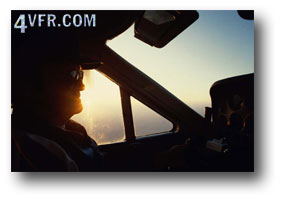Where Do You Want To Go Today?
You've decided to learn to fly, but do you have a clear idea of how you will use your pilot's certificate? Do you plan a career in aviation or will you fly for pleasure, personal transportation, and perhaps in connection with business as well?
If you know for certain where you are headed with your pilot's certificate, great! It makes it easier to design your primary instruction. But there's no need to worry if you haven't specifically mapped out your future as a pilot. Many people start out with the simple objective of learning to fly for the personal challenge it presents, and the fun of taking family and friends up. Then, as they become more experienced, they discover new opportunities and excitement and adopt more ambitious goals.
One thing you're probably certain about is whether or not you plan a career in aviation. If you do indeed aspire to become a professional, you should consider a full-time, career-oriented flight school. This option is discussed in "Choosing a Flight School." To summarize, you can attend an accredited college or university that offers aviation-related degree programs, flight training, and traditional non-aviation degrees. If you already have a college degree, you can enroll in an accelerated ab initio (from the beginning) school where you can earn a private, commercial, and even flight instructor certificates with multiengine and instrument rating ‚ the basic credential needed to enter the job market as a professional flight instructor or flight crew member.
 If, on the other hand, your flying will be strictly non-commercial, you have several training options. The fastest and least expensive route to the cockpit is to train for a recreational pilot's certificate. Though it imposes some restrictions on the type of aircraft you can fly and where, and also limits you to just one passenger, the recreational pilot's certificate is an attractive alternative to a private pilot's certificate if you are interested in flying aircraft in the local area for pleasure. And, if you decided later that you want to broaden your horizons, you can upgrade to a private pilot's certificate with additional training.
If, on the other hand, your flying will be strictly non-commercial, you have several training options. The fastest and least expensive route to the cockpit is to train for a recreational pilot's certificate. Though it imposes some restrictions on the type of aircraft you can fly and where, and also limits you to just one passenger, the recreational pilot's certificate is an attractive alternative to a private pilot's certificate if you are interested in flying aircraft in the local area for pleasure. And, if you decided later that you want to broaden your horizons, you can upgrade to a private pilot's certificate with additional training.
However, the recreational pilot's certificate is a relatively recent addition to the list of pilot certificates and ratings specified in the federal aviation regulations (FARs), and few flight schools and instructors have experience teaching it. If you are interested in pursuing a recreational pilot's certificate but find that it is not available in your area, consider talking to a local instructor and flight school about taking you on as their prototype recreational pilot student.
The traditional approach is to seek out an local instructor and flight school and earn a private pilot's certificate. It can be done with as little as 35 hours of flight instruction, including both dual instruction (flying with an instructor in the right seat) and solo flight time (you are the only one in the airplane). However, in practice, the 35-hour minimum applies to full-time students in an intensive, structured program.
Most people who train part time ‚ twice a week on average, before or after work or school and on weekends - log between 50 to 70 hours or more of instruction before earning their certificate. In addition to flight instruction, you will take ground school to prepare for the required written test, and at the conclusion of your flight instruction take a practical test ‚ an oral exam and flight check ride administered by an examiner who works for or officially represents the Federal Aviation Administration (FAA).
The one person who will be with you ever step of the way leading up to the practical is your flight instructor.

